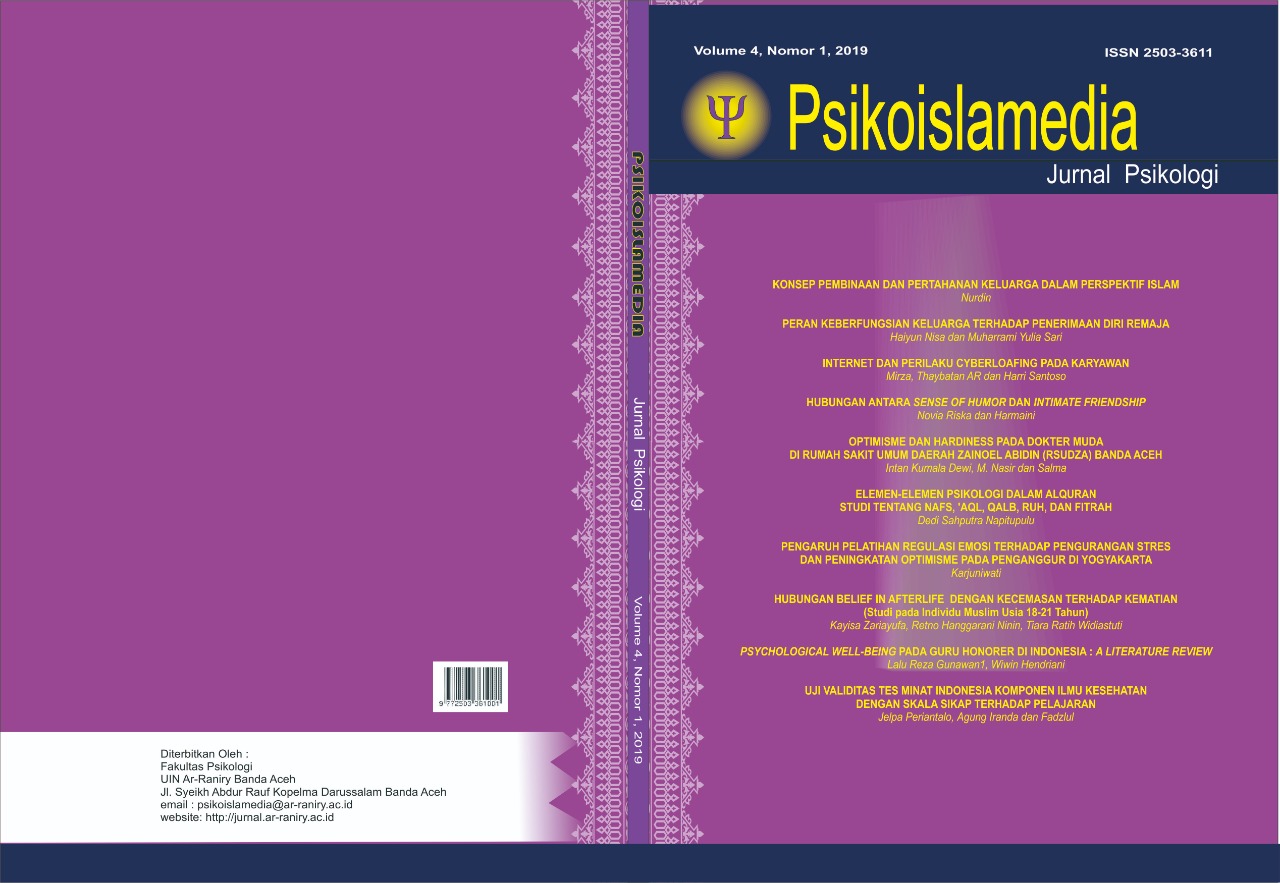References
Ardelt, Monika. Effects of Religion and Purpose in Life on Elders' Subjective Well-Being and Attitudes Toward Death. Journal of Religious Gerontology, 14(4), 55-77. doi: 10.1300/J078v14n04_04
Burke, dkk. (2010). Two Decades of Terror Management Theory: A Meta-Analysis of Mortality Salience research. Personality and Social Psychology Review, 14(12), 155.195. doi: 10.1177/1088868309352321
Burris, & Bailey. (2009). What Lies Beyond: Theory and Measurement of Afterdeath Beliefs. The International Journal for the Psychology of Religion, 19(3), 173-186. doi: 10.1080/10508610902879982.
Christensen, L. B. (2007). Experimental Methodology (10 ed.). Boston: Allyn and Bacon.
Cicirelli, V. G. (2001). Personal Meanings of Death in Older Adults and Young Adults ini Relation to Their Fars of Death. Death Studies, 22, 713-734. doi: 10.1080/713769896
Ellis, L. & Wahab, E.A. Religiosity and Fear of Death: A Theory-Oriented Review of the Empirical Literature. Review of Religious Research, 55(1), 149-189. doi: 10.1007/s13644-012-0064-3
Fatimah. (2012). Gender dalm Bingkai Budaya, Islam dan Transformasi Sosial. Musawa, 4(1), 59-70.
Firestone, R. & Catlett, J. (2009). Beyond Death Anxiety. New York: Springer Publishing Company.
Flannelly, K.J. (2017). Religion and Death Anxiety. Religious Beliefs, Evolutionary Psychiatry, and Mental Health in America, 153-164. doi: 10.1007/978-3-319-52488-7_16
Ghayas, S., & Batool, S. S. (2016). Construction and Validation of Afterlife Belief Scale for Muslims. Journal of Religion and Health, 56(3), 861-875. doi: 10.1007/s10943-016-0258-z
Heflick, N. (2011). Believe or Go to Hell- Does this Message Work? Diakses pada 5, 2017, dari https://www.psychologytoday.com/blog/the-big-questions/201105/believe-or-go-hell-does-message-work
Hood, H. S. (2009). The Psychology of Religion. New York: The Guilford Press.
Jalaluddin. (2016). Psikologi Agama. Jakarta: PT RajaGrafindo Persada.
James, A., & Wells, A. (2002). Deah beliefs, superstitious beliefs and health anxiety. British Journal of Clinical Psychology, 41, 43-53. doi: 10.1348/014466502163787
Jonas, E. & Fischer, P. (2006). Terror management and religion: Evidence that instrinsic religiousness mitigates worldview defense following mortality salience. Journal of Personality and Social Psychology, 91, 553-567.
Jong, J., dkk. (2017). The Religious Correlates pf death anxiety: a systematic review and meta-analysis. Religion, Brain Behavior doi: 10.1080/2153599X.2016.1238844
Krause, N. (2015). Trust in God, Forgiveness by God, and Death Anxiety. OMEGA, 72(1), 20-41. doi: 10.1177/0030222815574697
Lickerman, Alex. (2011). The Two Kinds of Belief. Diakses pada 4 Maret 2018, dari https://www.psychologytoday.com/blog/happiness-in-world/201104/ the-two-kinds-belief
Lonetto, R., & Templer, D. I. (1986). Death Anxiety. Washington, DC: Hemisphere Publishing.
Nolen-Hoeksema, dkk. (2009). Atkinson & Hilgard's Introduction to Psychology. Andover: Wadsworth Cengage Learning.
Nyatanga, B., & de Vocht, H. (2006). Towards a Definition of Death Anxiety. International Journal of Palliative Nursing, 12, 410-413. doi: 10.12968/ijpn.2006.12.9.21868
Ozretivh, R., & Bowman, S. (2001). Middle Childhood and Adolescent Development. Corvallis, OR: Oregon State University Extension Service.
Pierce, J.D. , dkk. (2007). Gender differences in death anxiety and religious orientation among US high school and college students. Mental Health, Religion & Culture, 10(2), 143-150. doi: 10.1080/13694670500440650
Rose, B., & O'Sullivan, M. (2002). Afterlife Beliefs and Death Anxiety: An Exploration of the Relationship between Afterlife Expectations and Fear of Death in an Undergraduate Population. OMEGA, 45(3), 229-243. doi: 10.2190/RV40-6NBR-66GF-UJMU
Santrock, J.W. (2007). Adolescence (12th Edition). USA: McGraw Hill Education.
Santrock, J.W. (2012). Adolescence (15th Edition). USA: McGraw Hill Education.
Smith, J., & Haddad, Y. (2002). The Islamic Understanding of Death and Resurrection. Oxford: Oxford University Press.
Suryabrata, S. (2005). Psikologi Kepribadian. Jakarta: PT RajaGrafindo Persada.
Templer, D.I. (1972). Death Anxiety in Religiosly Very Involved Persons. Psychological Reports, 31(361-362). doi: 10.2466/pr0.1972.31.2.361
Templer, D. I. (1976). Two-Factor Theory of Death Anxiety. Essence, 91-93.
Templer, dkk. (2006). Construction of Death Anxiety Scale-Extended. OMEGA, 53(3), 209-226. 10.1080/00221309.1970.9920634
Wen, Y. (2010). Religiosity and Death Anxiety. The Journal of Human Resource and Adult Learning, 6(2), 31-37.
Wicaksono, W., & Meiyanto, S. (2003). Ketakutan Terhadap Kematian Ditinjau dari Kebijaksanaan dan Orientasi Religius pada Periode Akhir yang Berstatus Mahasiswa. Jurnal Psikologi, 1, 57-65.
Wijaya, F. S., & Safitri, R. (2010). Persepsi terhadap Kematian dan Kecemasan Menghadapi Kematian pada Lanjut Usia (Naskah Publikasi. Diakses dari: http://fpsi.mercubuana-yogya.ac.id/wp-content/uploads/2012/06/Naskah-Pubikasi-Ranni-dan-Freddy.ok_.pdf



